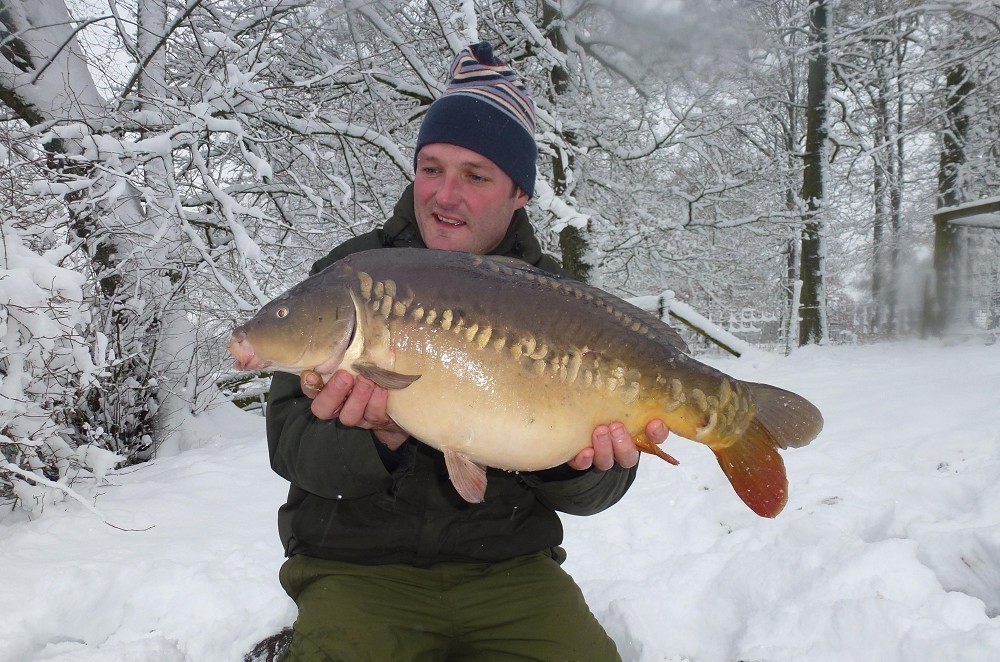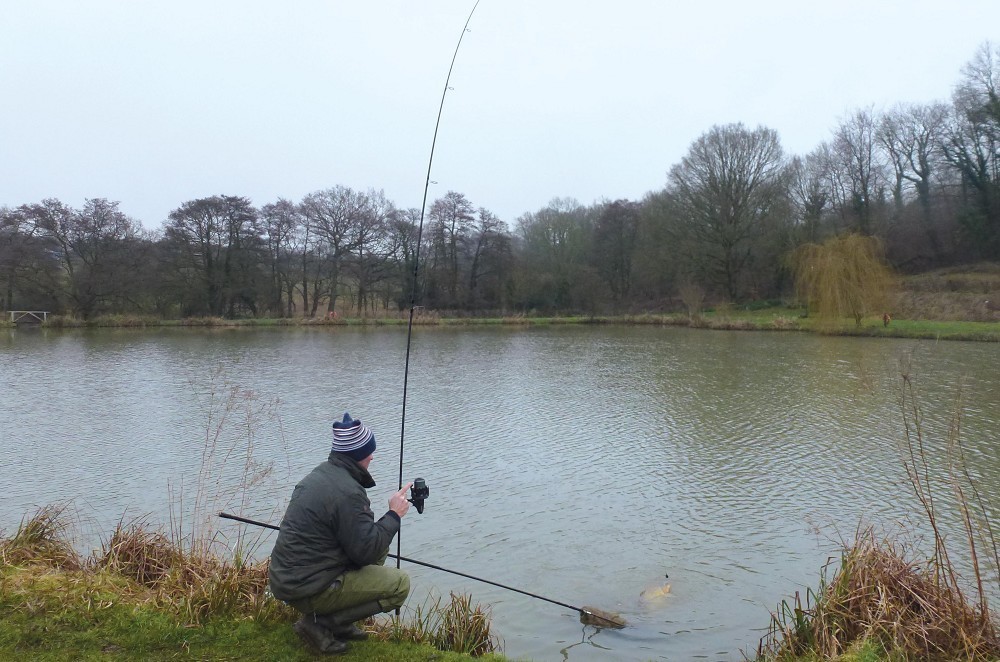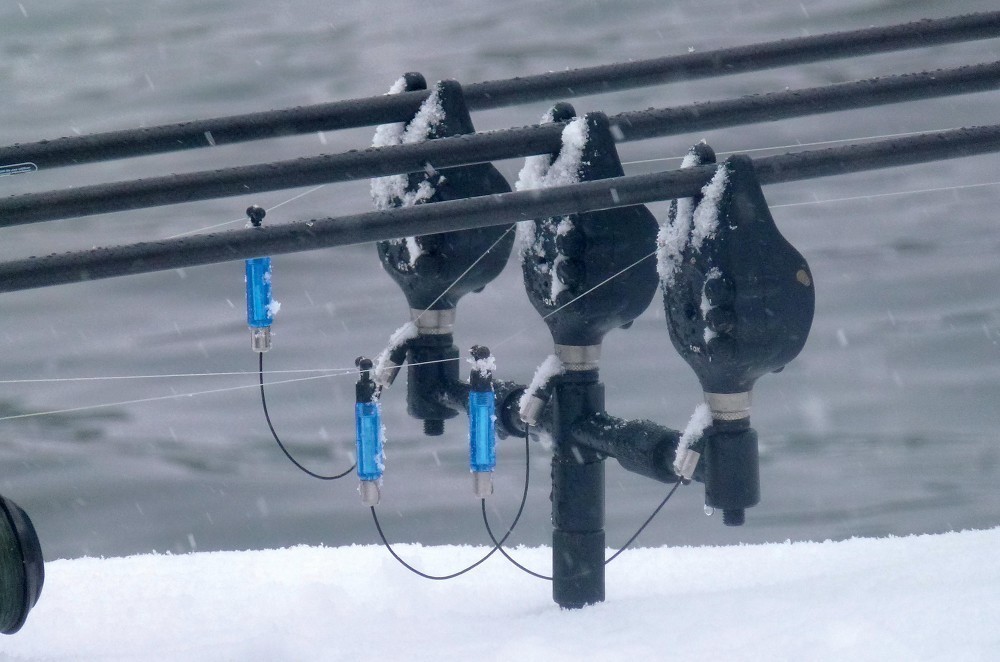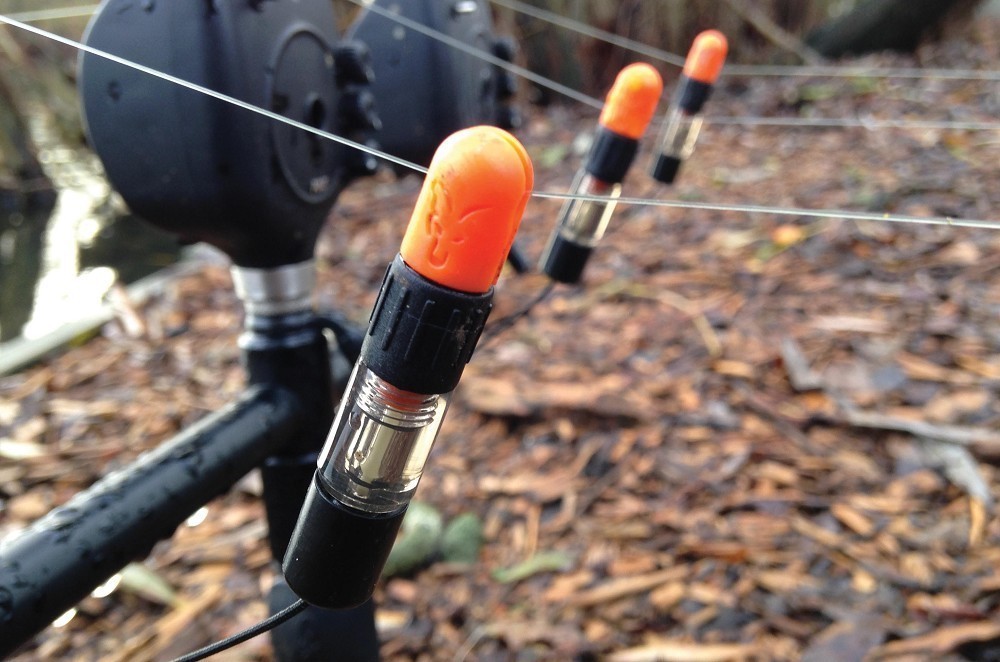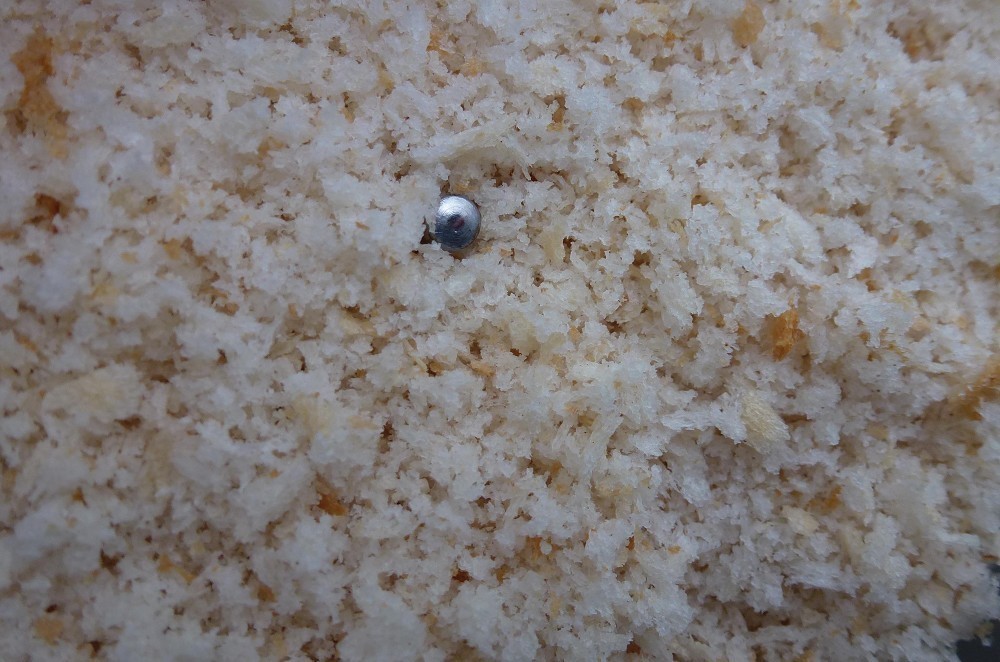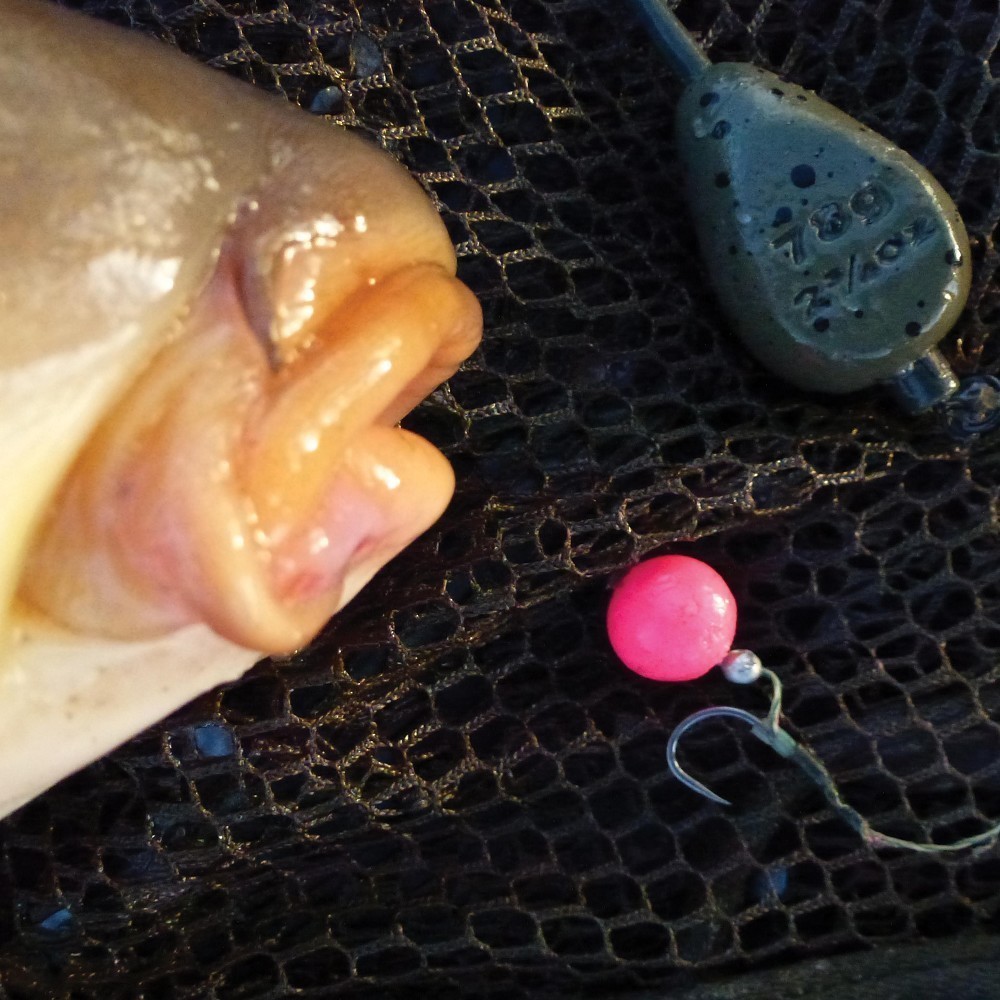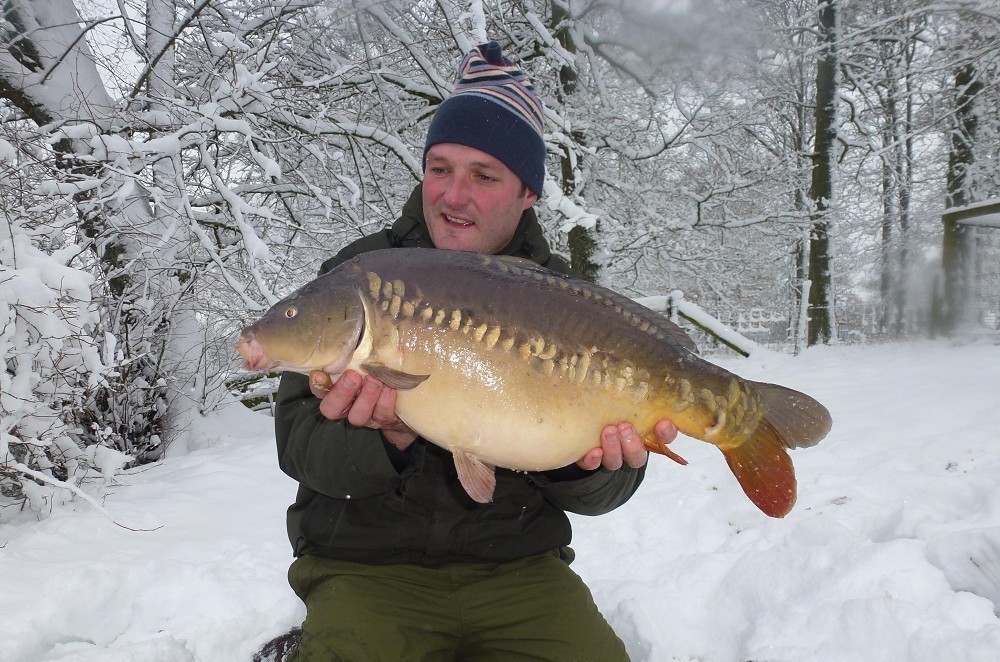How to get the best out of your winter fishing
Rob Hughes has got an amazing record for winter captures, whether it’s big fish hunting or “smashing ’em up”, and his method for success? Keep active…
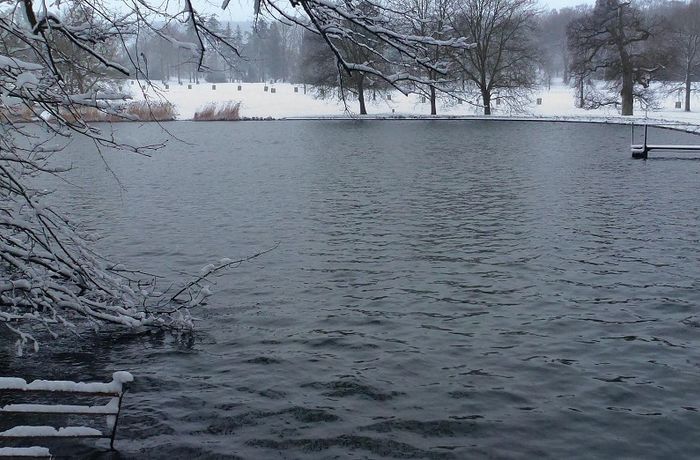
How often do you recast? Sometimes the rods can go out once a day and stay out all day. Every now and again we’ll have a re-chuck, most of the time because we think we should, and occasionally because we have seen a fish and are making that extra bit of effort. A lot of the time the rods go out for a few hours and stay out for no other reason than they are out.
Three winters ago I read something that “me old mucker” Simon Crow had written about the effort that he puts into his fishing. It really got me thinking that my effort levels had slipped a little. Not the effort that I made when I was on the bank, that is always high, but the effort level in getting out there in the first place. It was always easy to come up with an excuse. Too cold, too wet, no time to get the gear ready, too much to do…. you know the score. I decided to put that right and pull my finger out and subsequently had one of the best winters I’ve ever had for fish numbers, whilst fishing short sessions only.
The key for me was activity. Sitting down is boring. Humping loads of kit round is difficult, and moving once you’re set-up is a pain in the arse. I picked a water that was local enough to get to easily and regularly, got my head together, and stripped my kit down to the absolute bare minimum. I was mobile, fast and enthused.
Day time action
One of the great things about winter carp fishing is that the action tends to come more in the day time than the night time. First light through until 11 o’clock in the morning always seems to be a good time and has been on a number of waters for me. The great thing about this is that first light is 07:00hrs onwards so if your water is close enough to you it means a 6am start, which isn’t too bad at all really. I can’t emphasise how important getting there at first light is. For a start you need to be in the peg before anyone else is, but secondly that first light feeding spell is a massive opportunity. One water I fished was a day only water and the walk to the hot swims was a long one. My stripped down approach (I didn’t even take a chair with me) meant that I was out of the car and off really quickly. I can recall that there were a couple of occasions that I was playing a fish off a quick chuck when the next guy had only just got round to me pushing far too much stuff on his barrow. Travel light – be quick.
Look for liners
It goes without saying that any fish spottings should be acted upon immediately, especially if you are fishing three rods. Always have at least one which is a ‘rapid reaction rod’. However, you can use your rods to find where the fish are and liners are a brilliant way of doing this. The carp almost will almost always group up with each other somewhere, especially if you are fishing one of the smaller “Simmo” type waters (which are great for winter action in my mind). Once you find the group you are quids in. I’m usually a massive advocate of tight lines but in winter I prefer to fish semi slack with very light bobbins that will move on any slight movement from fish touching the line. As soon as I get a liner I will move another rod close to that spot to try and locate them and very often put the other on the other side to try and track where they are. You can narrow it down and you’ll soon find ‘em.
Bread is a mega winter edge
Here’s a great little edge for you. Grab two slices of white bread, blend one, putting it into your mix the night before you go fishing so it will soak up the liquid. Leave the other one out to go dry overnight. In the morning while the kettles boiling for your flask, blend the other then put the dry bits in the with the mix too. They will take on some of the liquid but will rise up out of your mix underwater at a different rate to the other bits and make it active/help pull fish down.
Crush some pop-ups
Sounds crazy but it’s true. I get a few yellow and a few pink pop-ups and crush them almost to dust. They go in too and, like the bread, rise up slowly off the bottom as another attractor.
Hughesy's Stick Mix ingredients:
2mm Coarse Pellets
Handful of Crayfish Mini Mix for crunch
2 slices bread (white)
Handful crushed Nutta boilies
Splash of Feedstim XP
Dash of DNA Liver Extract
Crushed pop-ups
Lick of Wraysberry Liquid
Mini sticks are ace
I know people talk about piling the bait in during the winter, and that’s great for campaigns and also a longer session but for short session Hit n Run fishing like the sort of thing I tend to do I’m on minimal bait. In fact, if it’s a quick hit trip I don’t take boilies with me. They’re for longer-term campaigns on a water or a session bigger than I have got time for. The other great advantage is that it means your bait bill is minimal. In fact, it’s almost nothing as liquids, pellets and a few boilies will last me loads of trips. Depending on the action/re-cast rate I would say that you’ll get half a dozen trips out of £30 quid’s worth of bait. Now that’s great value. What I do is make up a load of Stick mix the night before and allow the liquids to soak into the ingredients to make a really smelly and attractive bait. I don’t want to feed them, I want to attract them. Make sure the mix is damp and it will work a treat. Solubility and visibility are the keys to attraction and stinky sticks are an absolute winner.
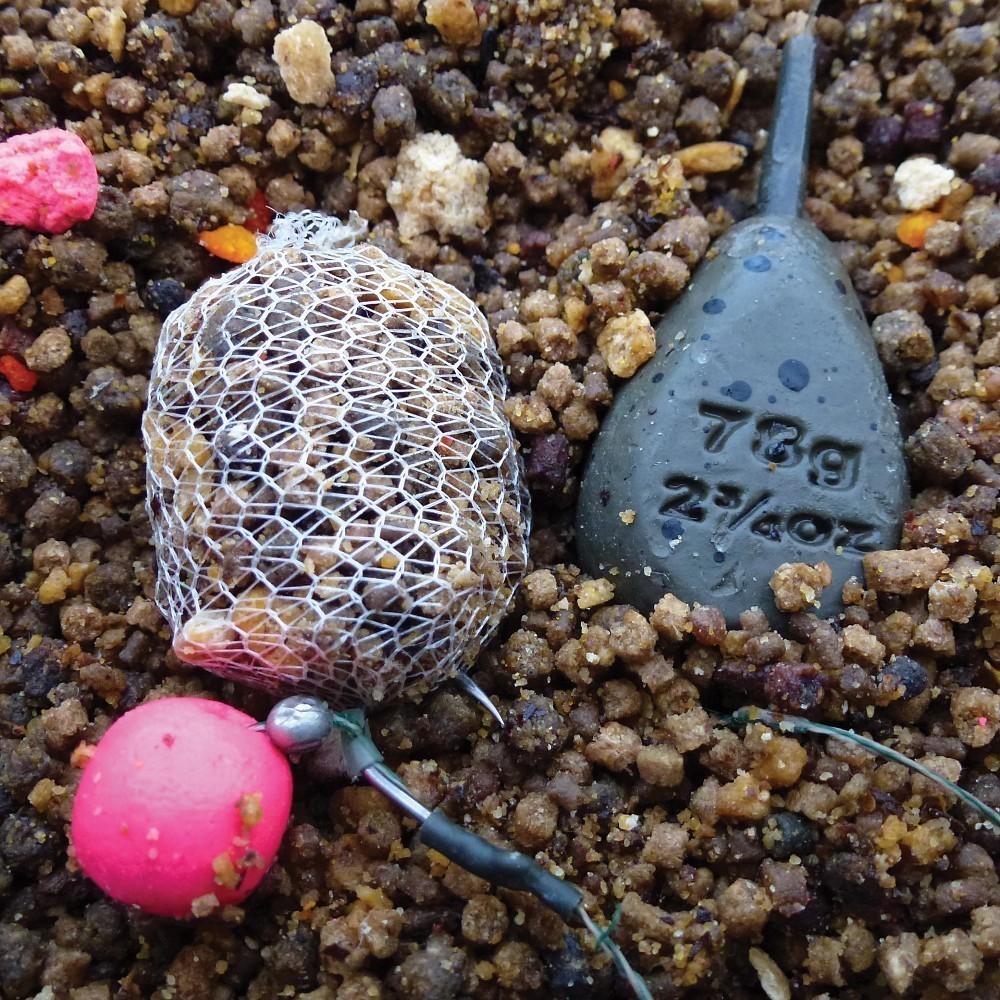 A reasonable light lead and a small Stick/bag of smell is all I need to catch fish. Quick easy and deadly
A reasonable light lead and a small Stick/bag of smell is all I need to catch fish. Quick easy and deadly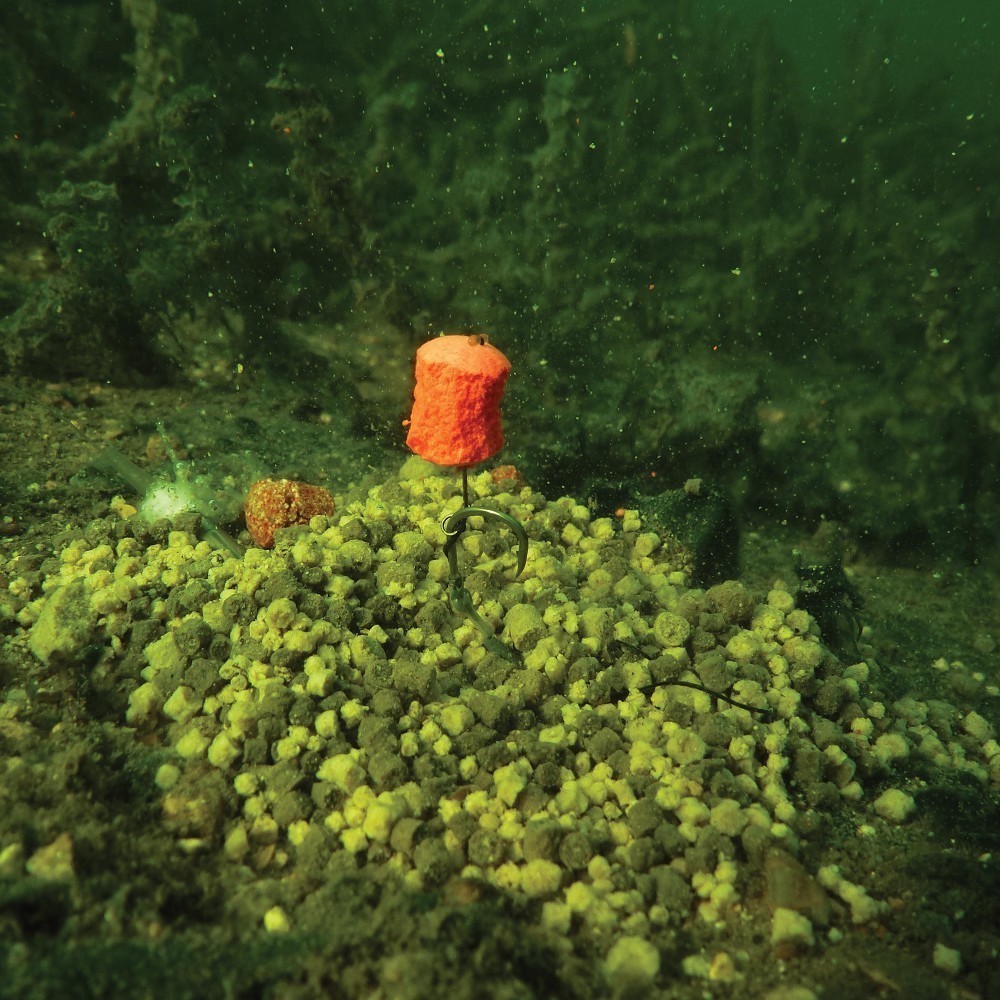 A bigger bag with some “floating bits” and you can see how the addition of light particles adds a little extra to the attraction properties
A bigger bag with some “floating bits” and you can see how the addition of light particles adds a little extra to the attraction properties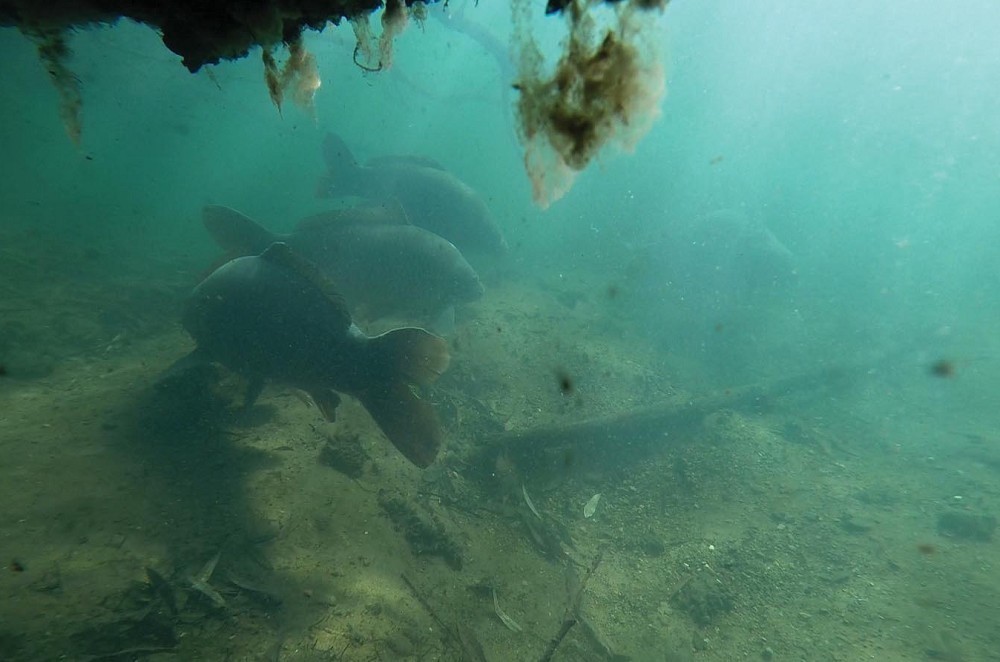 Feel the lead down as they very often group up in winter and you can find them with a light lead and a flick around
Feel the lead down as they very often group up in winter and you can find them with a light lead and a flick aroundFeel the lead down
Using the lead, especially on deeper waters, is an absolute winner when it comes to fish location. You can very often feel the lead bump off fish, or the line ping off their back as it drops. Keep the rod high, let the lead drop on a tight line, and concentrate on the line falling. Count how long it takes to hit the deck and remember it. When you re-cast, anything that feels slightly out of the ordinary could be a carp, generally off the bottom, and that will help your location. It’s quite easy to dismiss someone when they say that they felt one as they cast out, but it happens regularly and when you know what to look out for it’s a massive help. If you really want to be on the ball, when you haven’t got the chance to fish but you do have an hour free and you’re not disturbing anyone, nip down to your lake, pop a light-ish lead on and have a flick around. You’ll be amazed what you can find and as long as there hasn’t been a big change in conditions before your next visit, that info will certainly help you.
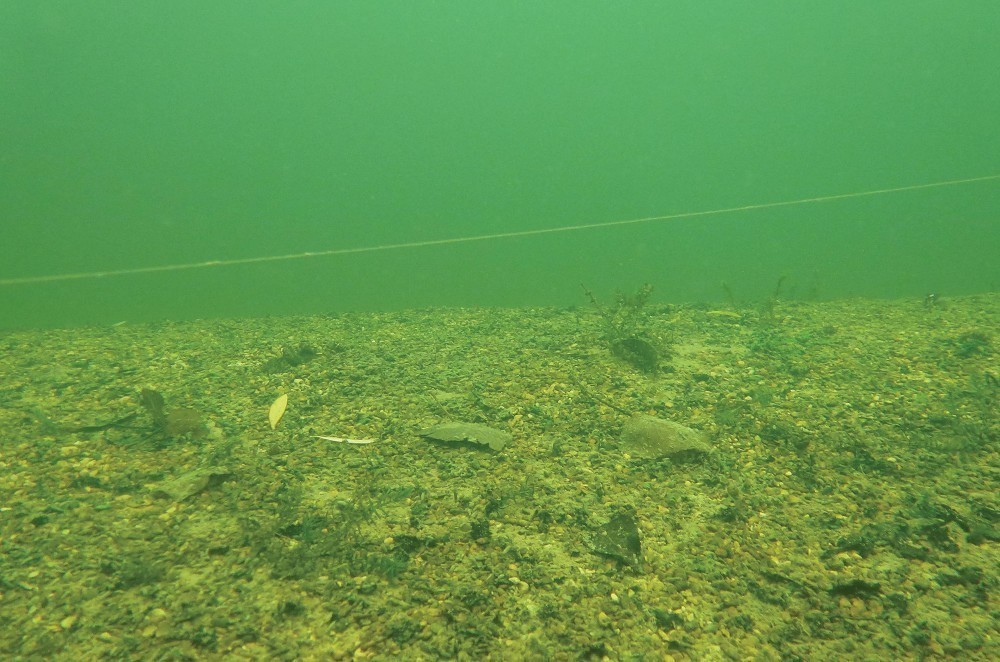 Make sure your choice of line is the correct one for winter. Using a neutral line helps locate liners
Make sure your choice of line is the correct one for winter. Using a neutral line helps locate linersStrange but true
Hughesy actually changes his line colour and type in the winter. The green line comes off and the brown Warrior line goes on as it is less visible underwater. The other thing he does is makes sure the line is a neutrally buoyant one rather than a sinking/floating one as it’s much better for spotting liners. Now that’s attention to detail!
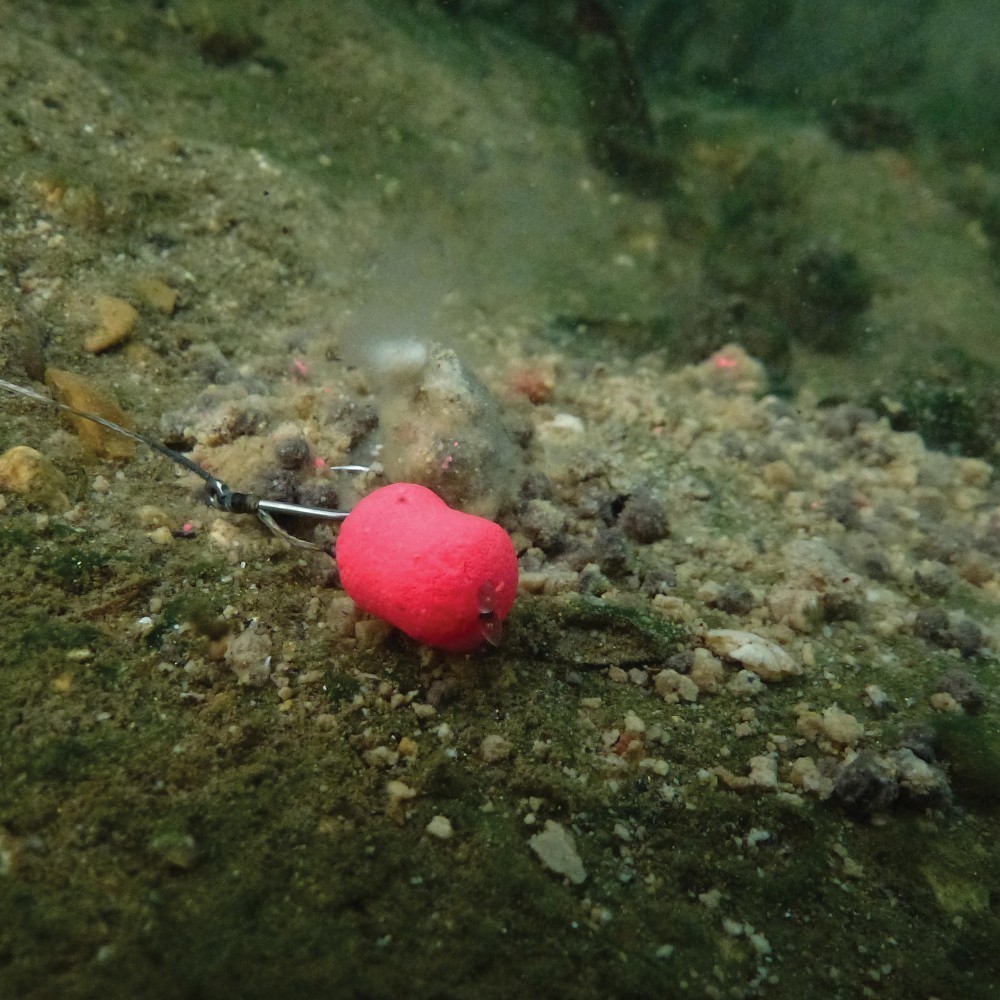 A Wraysberry wafter and a small Stick. Not a lot of food but a lot of smell and you can see how vivid the colour is
A Wraysberry wafter and a small Stick. Not a lot of food but a lot of smell and you can see how vivid the colour isBright baits
Hookbait choice is easy in the winter: it has to be bright and it has to be balanced. The sort of waters I fish this style are usually relatively high stocked lakes which have little or no weed. As a result I can get the bait on the deck with no problem so I’ll fish a wafter or a trimmed down balanced pop-up sitting just on top of the Stick. There are usually two choices, and they are PBs or Wraysberries, both by DNA. Occasionally I’ll venture over to a Pink Peril which is a lighter shade of pink, but the day-glow nature of the PB (yellow) and the Wraysberry (vivid pinky red) really are devastating. I’m sure others will have their own views, but I cannot stress enough how important the colour of your bait is, especially at this time of year. As the water clears, the little fleck of colour can make all the difference. Chop and change to find the best one for your lake but try PB or Wraysberries as a starter.
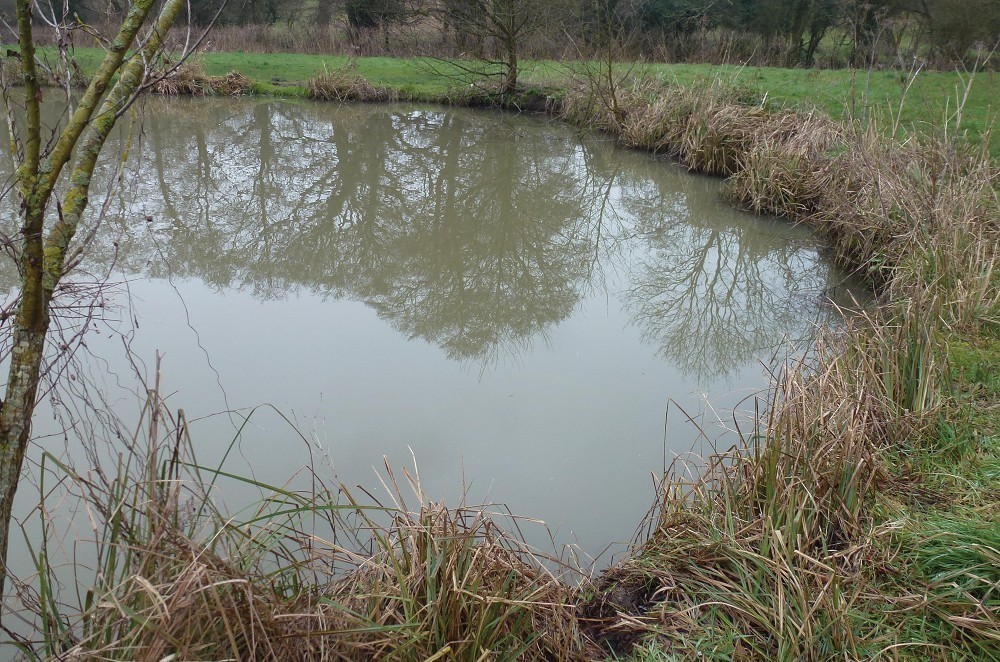 They can be anywhere from right out in the open in a ball to tight in the edge. 3ft deep margins like these can be very productive
They can be anywhere from right out in the open in a ball to tight in the edge. 3ft deep margins like these can be very productiveRe-cast to stay on 'em
The last thing I’ll say is probably one of the most important keys to winter success. Recast regularly until you see a pattern develop. Where you get a shoal grouping up for winter they will find where they want to be and will generally stay there until they are moved by something. That something can be a big change in weather like the December storms we had, angler pressure or otters, etc. However, it means that something has to make them move. They generally stay more or less in the same place until that change happens. Regular re-casting is a great way of finding them and it also has the added benefit of re-placing your hookbait and ensuring your presentation is right. You don’t want to be fishing for ages with a rig that’s either tangled or messed up in some way as it’s sitting wrong.
If you are worried about re-casting then don’t. Have a think about all the times that someone has said to you, “It’s only been out there five minutes.” On higher stocked waters they generally are not bothered about a bit of casting. The other great advantage is that you are topping up the swim like a feeder angler tops his peg up. Little pimples of smell with virtually no food but lots of attraction are brilliant for stimulating the fish to have a go and the re-casting is serving yet another great purpose.
Hughesy's hit 'n' run method
The first three or four mini Sticks will have been made up at home ready to go so when I arrive they are fired out. Three rods are in position and I’ll watch the water for any movement. If I see anything I’ll happily move one or more of the rods even if they have only been in for a matter of minutes. After 15 minutes I’ll move the first one. That involves tying up a new Stick, reeling in and re-chucking. It won’t go far away, almost like I’m working a swim with a spinner. 5 to 10 minutes later the middle rod will have the same treatment, and then 5 to 10 minutes later the right. It means that I am literally re-casting at least one rod every 5 to 10 minutes. If I get a bite or a liner, then all three rods go in the same area a metre or so apart and they will be moved ever so slightly on the re-cast unless I see something move elsewhere. It’s mad to be honest.
I sometimes take a chair but a lot of the time don’t, and other anglers look at you as if you are mad or a noddy. When I start catching fish they tend to have a re-think, and when I really start sacking up they start following suit. By which stage it’s job done for me and I’m on my way home, really quickly, because I haven’t got a lot of gear to cart around. A lot of the time my winter sessions are first light until early afternoon, stop off to pick my son up from school on the way back and home for tea.
If you’ve got a hi-stocked water by you I’d urge you to have a go. It’s great fun and really different from the normal style of carp fishing that we do. It keeps you on your toes and active and is immensely rewarding too.





